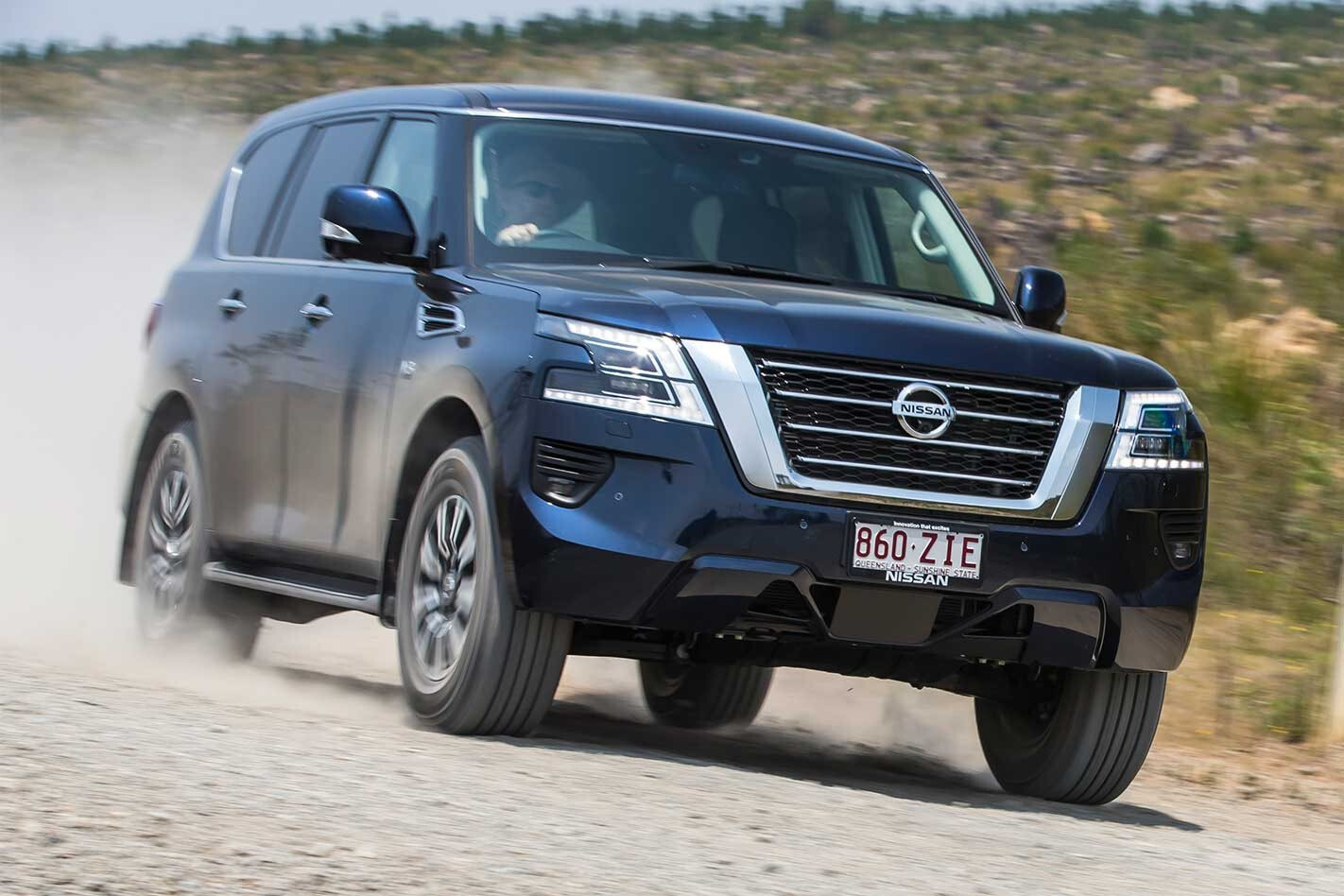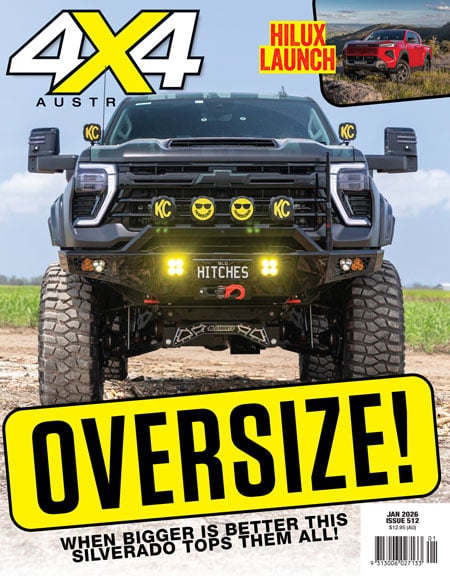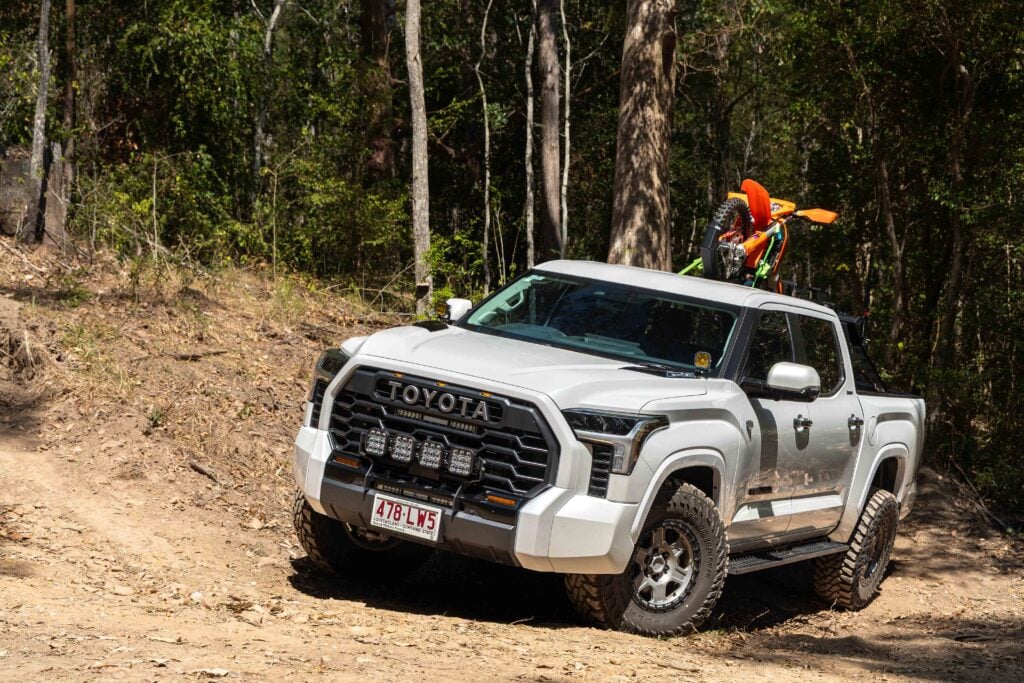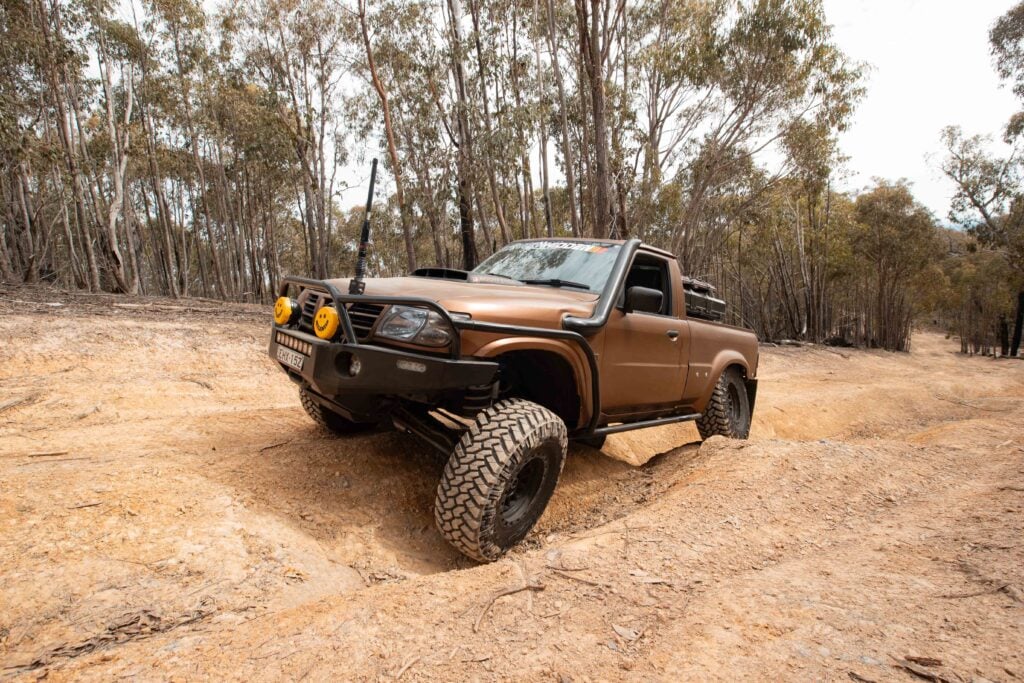Nissan has given the Patrol a freshen-up for MY2020 with new styling front and rear, tweaks to the suspension tune, and the inclusion of new safety features on both Ti and Ti-L models.
While midlife style updates often don’t do the original vehicle design justice, the new-look Patrol works well, giving the vehicle a sharper and more integrated overall look that slightly minimises the once bulbous appearance of this undeniably big eight-seat wagon.
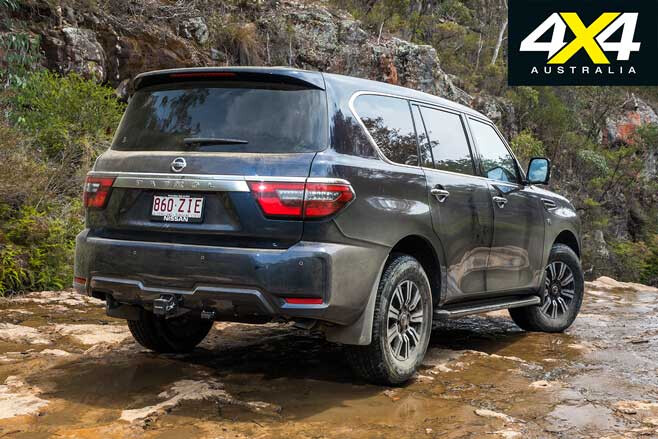
At the front new LED lights and grille combine with two new bumper designs to give the Patrol a more modern appearance. The Ti model grade (as tested) scores what Nissan describes as “a unique sporty front-end design”, while “the Patrol Ti-L front bumper showcases a more premium look”; essentially, the Ti-L bumper has more horizontal lines, more chrome and relocated fog lights. Changes at the rear of both model grades include a slightly different tailgate pressing, redesigned LED tail-lights and a full-width chrome strip with integrated nameplate, giving a tidier and wider overall look.
The equipment changes mostly centre around upgrades to Nissan’s Advanced Driver-Assistance Systems (ADAS). Both the Ti and Ti-L models are now equipped with Intelligent Emergency Braking, Intelligent Forward Collision Warning and Rear Cross Traffic Alert.
Once exclusive to the Ti-L, the lower-grade Ti now also comes with Intelligent Cruise Control (ICC), Lane Departure Warning (LDW), Intelligent Lane Intervention, Blind Spot Warning (BSW) and Intelligent Blind Spot Intervention. Both models now have auto-folding exterior mirrors.
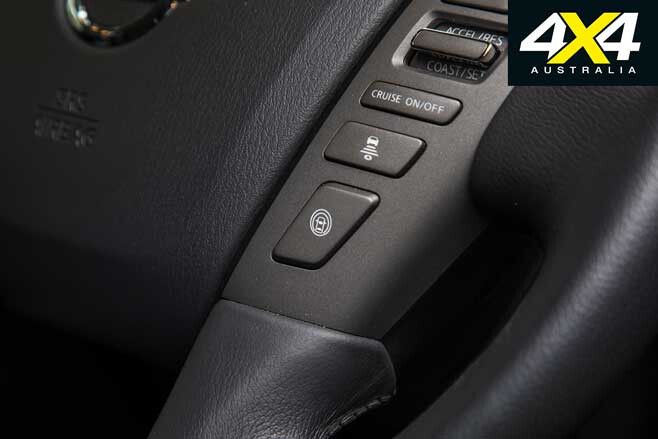
These upgrades come at a cost, with the Patrol Ti up by $3110 to $75,990 plus on-roads, and the Ti-L up by $2110 to $91,990 plus on-roads. Despite these modest increases the Patrol is still a relative bargain compared to its most obvious direct competitor, the LandCruiser 200 Series; the well-equipped Patrol Ti is around $4K cheaper than a stripped-out LandCruiser GX, while the top-of-the-range Patrol Ti-L is the same price as a basic LandCruiser GXL. And if you want a Cruiser nearing the Patrol for equipment spec, you’ll need to fork out more than $102K for a VX or more than $123K for the top-spec Cruiser Sahara.
Regardless of the Patrol’s apparent bargain status, the LC200 outsells it on the Aussie market at a rate of almost eight to one. This can be largely attributed to the lack of a diesel engine in the Patrol, which is exclusively powered by a 5.6-litre petrol V8, while the LC200 now comes exclusively with Toyota’s 4.5-litre turbo-diesel V8. The market has spoken … and the market says “diesel rules”.
Powertrain
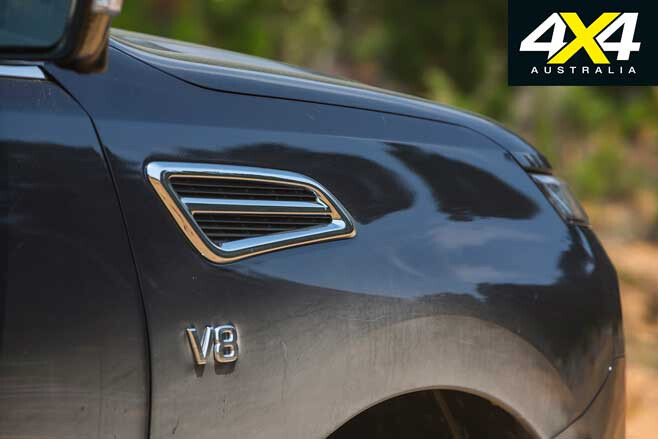
Okay, let’s start with the bleeding obvious: the Patrol is a bit of a gas guzzler. But its VK56VD engine is no old-school petrol V8 dinosaur. Despite a ‘no substitute for cubic inches’ 5.6-litre displacement, this lightweight aluminium-block V8 is a high-tech wonder, with aluminium heads, double overhead camshafts, four valves per cylinder, direct injection technology for optimum combustion efficiency, and Variable Valve Event and Lift (VVEL) for greater fuel efficiency and output. Claimed peak power is a handy 298kW at 5800rpm and torque peaks at a grunty 560Nm at 4000rpm.
The Patrol itself is no lightweight, however, and in Ti guise it weighs in at a rather hefty 2812kg, so you need to be quite generous with throttle application if you want to make the most of all that on-paper output. Being a big petrol V8, that kind of driving style will have consequences at the fuel bowser.
Nevertheless, put your boot into it and the Patrol will launch off the line with enthusiasm, before it settles into a period of rather linear acceleration throughout the mid-range. Keep your foot planted and the tacho needle goes ballistic from 5000 to 6200rpm in the lower gears, before the seven-speed auto reaches for another ratio. The whole affair is accompanied by a satisfying (if muffled) petrol V8 soundtrack that no diesel engine could ever hope to match.
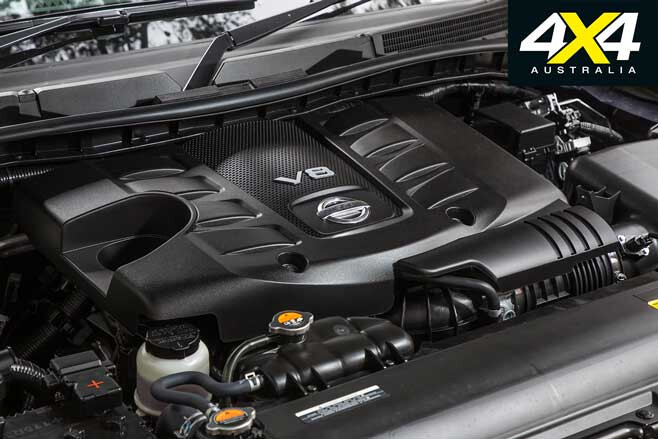
Of course, you can’t drive around like a hoon all day long, and if you’re happy to plod along at a reserved pace you’ll soon realise one of the other great benefits of this V8 petrol engine; it’s super smooth, quiet and refined … and not too thirsty. On test we recorded a surprising average fuel consumption figure of 15.2L/100km, which included a mix of city, country and off-road driving, but consumption can drop to as low as 12 to 13L/100km on the freeway.
The Patrol’s seven-speed auto shifts smoothly and offers more than enough ratios for poking around town or cruising on the open road. It can sometimes be a little slow to downshift when you want to press on, but this can be quickly resolved with a prod of the throttle or by knocking the shift lever over to the left and changing gears manually.
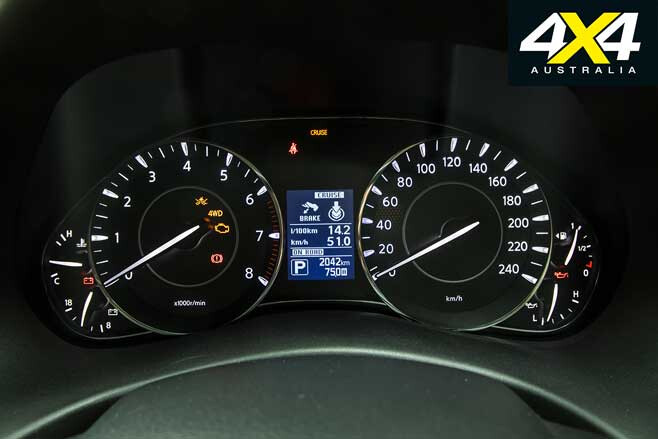
The Patrol uses Nissan’s Intelligent 4×4 system which in ‘Auto’ mode is essentially an on-demand 4×4 system that directs most torque to the rear wheels unless slip is predicted or detected, at which point it will transition up to 50 per cent of torque to the front wheels. The torque transition is seamless. As well as ‘Auto’, there are user-selectable ‘4H’ and ‘4L’ modes for off-road driving conditions, and these are engaged via a dial on the centre console. While ‘4H’ can be selected on the fly, you have to stop and shift into neutral to engage ‘4L’. The low-range gearing offers a crawl ratio of 43.95:1.
The 4×4 system also offers a range of modes to suit different driving conditions (On Road, Rock, Snow and Sand) essentially tailoring throttle sensitivity and transmission function to suit, and the Patrol also features Nissan’s Active Brake Limited Slip (ABLS) traction control system, as well as a user-lockable rear differential lock.
On-road Ride & Handling
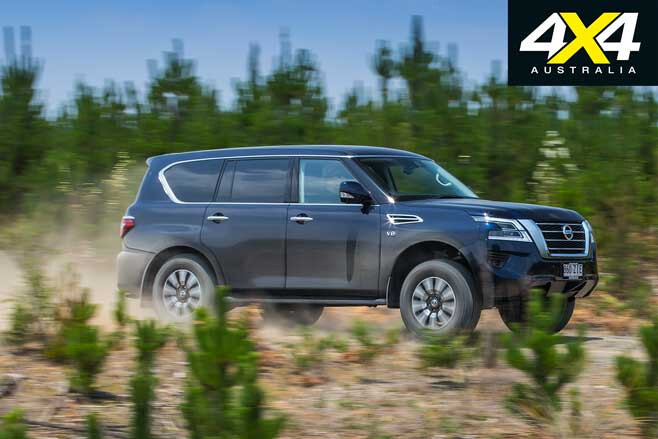
Despite its bulk and weight, the Y62 has always delivered surprisingly agile handling combined with a plush yet controlled ride, and this is still the case despite Nissan tweaking the suspension tune for MY2020. The Patrol’s fully independent double wishbone suspension is key here, with much less unsprung weight than a live-axle arrangement, but the trick Hydraulic Body Motion Control (HBMC) system also plays a big part in how the Patrol drives on the road.
The HBMC system essentially cross-links four oil cylinders (or hydraulic rams) via accumulators and hydraulic pipes so that when cornering, the fluid from the two outside rams flows to the accumulators to raise roll stiffness, which in turn minimises body roll. These rams essentially fulfil the dual functions of shock absorbers and sway bars. The result is a compliant ride when driving over rough surfaces, but the suspension ‘firms up’ when cornering for a sporty feel.
The Patrol rides on 265/70R18 Bridgestone Duelers so there’s plenty of sidewall to soak up bumps, and while the vehicle-speed-sensitive power steering is nice and light at low speeds it firms up enough at higher speeds to offer reasonable feel and good feedback. Sure, the Patrol is no sports car on the road, but it offers more composed handling than any vehicle of this size and weight has a right to … and not at the expense of ride comfort.
Off-road
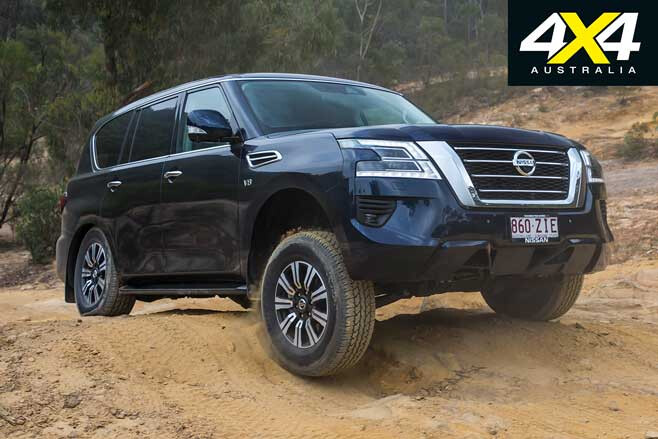
Another benefit of the Patrol’s HBMC system is that it doesn’t adversely affect wheel travel when driving off-road, as there are no sway bars. In fact, the Patrol offers impressive wheel travel both at the front and the rear, and it is this that is clearly on display when crawling over undulating terrain.
Other off-road positives include decent low-range reduction, an effective traction control system, good hill descent control, reasonable ground clearance (273mm) and a sturdy under-engine protection plate. The Patrol easily handled all of the off-road obstacles we threw its way including steep and undulating climbs, slippery descents and tight bush tracks.
On the downside, the traction control system disengages when the rear diff is locked, approach and departure angles are not fantastic, and the big side-steps are prone to grounding when driving over erosion drains or manoeuvring around obstacles.
Poor outward visibility doesn’t help in this regard, either (due to the big bonnet, high hipline and smallish rear window); although, the Patrol is equipped with a series of cameras allowing you to select different outward views (wheel placement, in front and behind the vehicle, or simulated 360-degree overhead) which proved handy when dropping over rock shelves or manoeuvring in tight spots.
Accommodation & Safety
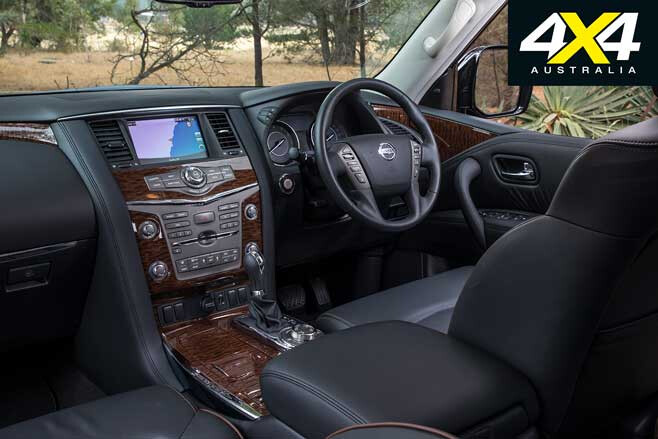
As you’d expect of a big eight-seat wagon, the Patrol offers generous interior space. The big, leather-covered front seats offer a good range of power adjustment, the driver’s seat gets lumbar adjustment, and the steering wheel is tilt/reach adjustable.
The dash design and instrument cluster are a little dated, the former with lots of faux wood and the latter with analogue gauges and monochrome graphics, and you have to reach for buttons around the instrument binnacle to scroll through trip-computer pages and reset the tripmeters.
The centre touchscreen is bright and colourful enough, but its dual controls (touch and dash-mounted buttons/dials) are awkward, while the lack of Apple CarPlay/Android Auto is an almost unforgivable oversight in this day and age. Other controls such as heating and ventilation require some user familiarisation; although, the 4×4 system and off-road mode controls are clearly marked and easy to use.
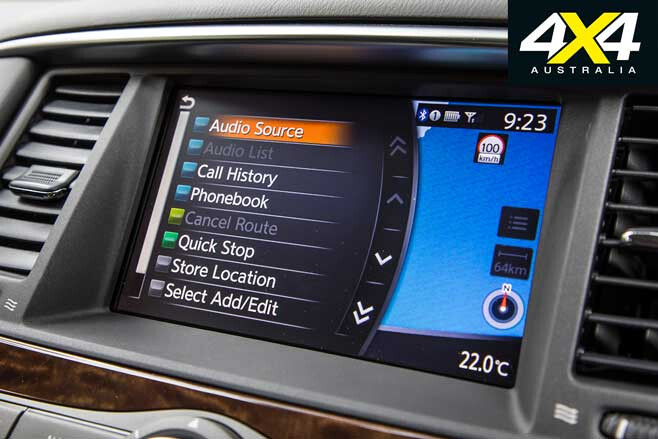
There’s plenty of storage space around the cabin including a big centre-console bin, a decent-size glove box and generous door pockets with bottle holders. There are two USB ports up front and two 12V power outlets.
The 60:40 split/fold second-row seat offers plenty of width for three occupants and good leg room, even in the centre position. There’s clever access to the centre console bin between the front seats from this row (it has a double-hinged lid), and those in the middle row also get large door pockets, AC controls, roof vents and two USB ports.
Access to the third-row seats is good thanks to tumble/fold second row seats, but once back there it’s quite cosy and really only suited to smaller kids. Fitting three across the third row would be a real challenge and, although the centre position has a three-point seat belt, there’s no headrest. There are roof vents and cup holders in the third row and the seat-backs have rake adjustment.

The cargo area is big enough to fit a 30-litre fridge and some other luggage, even with all three rows of seats in use. Fold the third-row seats down and the cargo area is huge. Fold the second-row seats down as well and it’s downright massive in the back of the Patrol, with an almost flat floor all the way to the back of the front seats. There’s a 12V power outlet in the cargo area, six cargo tie-down points and a small underfloor storage area suitable for wet or dirty gear. The one-piece lift-up tailgate is quite heavy and there’s no power assistance.
On the safety front, the Patrol packs the aforementioned Advanced Driver-Assistance Systems (ADAS), the usual array of three-letter abbreviations (ABS, TCS, VDC, EBD), driver and passenger front and side SRS airbags, curtain airbags for all three rows, two second-row ISOFIX and two top-tether child seat anchors, a third-row child seat anchor, and a tyre-pressure monitoring system (TPMS).
Practicalities
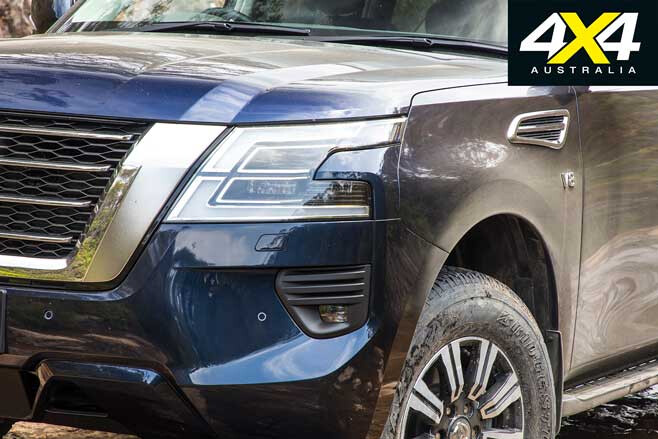
There’s no denying that the Y62 Patrol is a big beast, and when it comes to tight spots such as shopping centre carparks or bush tracks, it can be a handful; but the steering lock is reasonable and results in a 12.5m turning circle, which is on par with many 4×4 utes. The external cameras that feed the around-view monitor help in this regard.
The Patrol has recovery points fitted front and rear and a reasonable under-engine protection plate. Underbody components, including the underslung full-size spare wheel, are tucked up and out of the way.
There’s not much space under the bonnet, so those wanting to fit a dual-battery system will have to position the auxiliary battery under the vehicle or in a box in the cargo area. The air intake is located up high and through the passenger-side inner guard, but the alternator is located quite low in the engine bay.
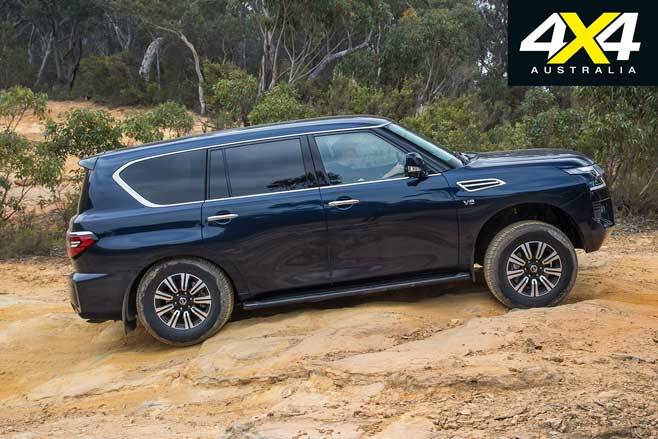
The Patrol might be a thirsty beast, but with a 140-litre fuel tank you’ll get more than 900km out of a fill, so long as you don’t get too heavy with the throttle. Nissan recommends 95 RON minimum, and there’s a sticker inside the fuel lid suggesting 98 RON, so your credit card will take a hammering at the servo.
The Patrol Ti has a decent 688kg payload capacity and it’s rated to tow a braked trailer up to 3500kg but, again, it’ll get thirsty with a big trailer on the back.
In Summary
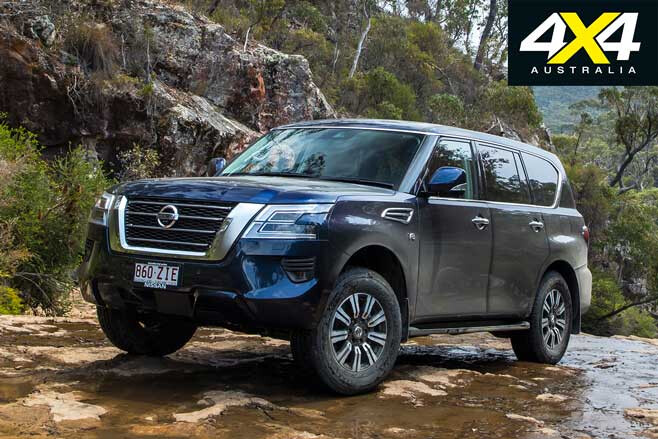
This latest update to the Y62 Patrol gives it a fresh, new exterior look, but it would’ve been nice if there were a few more updates on the inside, too. Nevertheless, the Patrol Ti is a fantastic vehicle, both on the road and off it, and it packs plenty of standard equipment for the asking price. As a petrol-V8-only proposition, though, it will always be a bit player in the upper-large 4×4 wagon segment.
Since the Y62 Patrol was launched in Australia back in 2012, there have been rumours of a diesel variant, and it’s a real pity such a model has never materialised because we reckon it would sell like hotcakes and give the 200 Series Toyota LandCruiser a run for its money, as well as some of the more expensive top-spec 4×4 utes.
NISSAN PATROL Ti SPECS: Engine: 5.6L petrol V8, direct-injection Max Power: 298kW at 5800rpm Max Torque: 560Nm at 4000rpm Gearbox: 7-speed automatic Crawl Ratio: 43.95:1 4×4 System: On-demand full-time 4×4 Construction: Separate-chassis Front Suspension: Independent/coil springs, linked hydraulic dampers Rear Suspension: Independent/coil springs, linked hydraulic dampers Wheel & Tyre: 18 x 8J alloy/265/70R18 116H Kerb Weight: 2812kg GVM: 3500kg Payload: 688kg Towing Capacity: 3500kg Towball Download: 350kg Departure angle: 23.6° Rampover angle: N/A Approach angle: 34.4° Wading depth: N/A Ground clearance: 273mm Fuel Tank Capacity: 140 litres ADR Fuel Claim: 14.4L/100km

